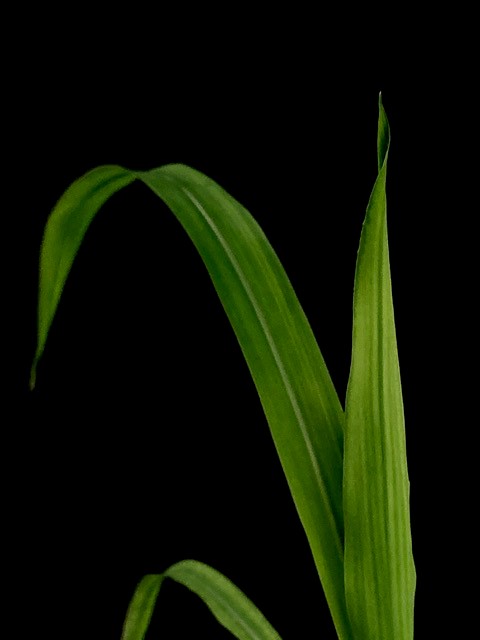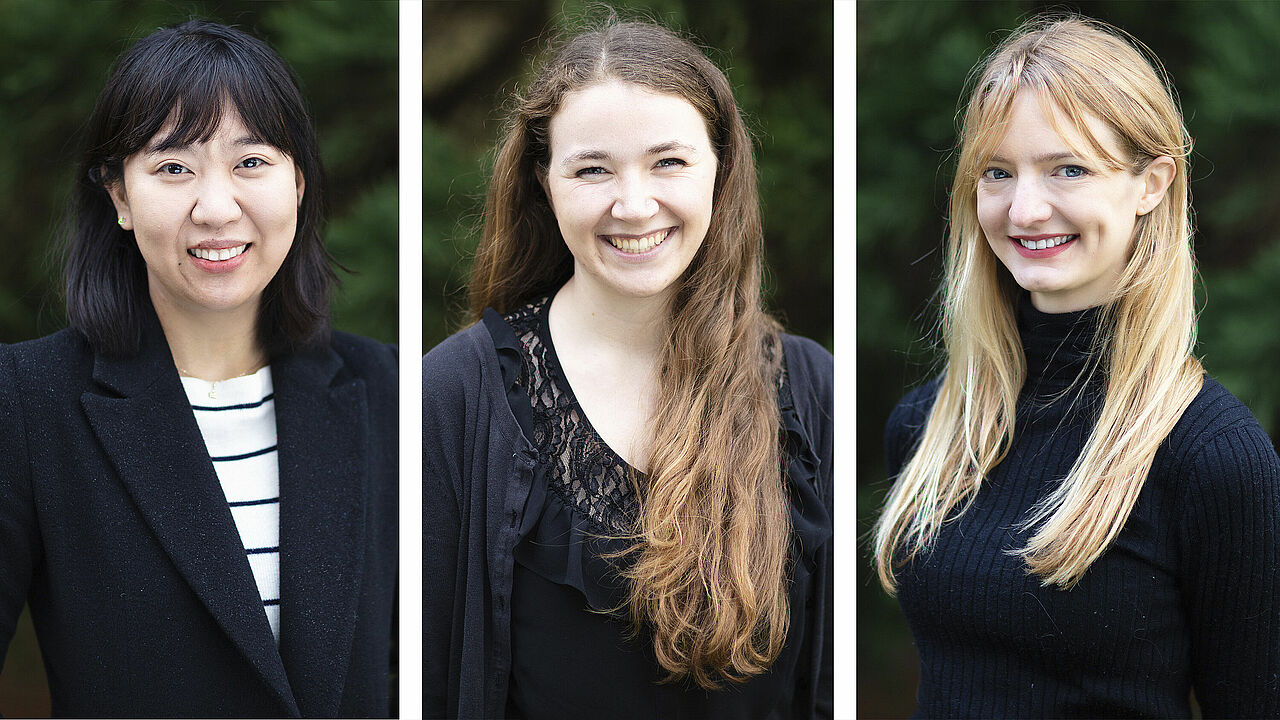Düsseldorf, Germany
January 8, 2020
Plant researchers at Heinrich Heine University Düsseldorf (HHU) have investigated the transport of compounds in maize. They focused on the mechanism used to transport the products of photosynthesis for further distribution in the plant through its phloem loading pathways. In the current edition of the journal “The Plant Cell”, they describe how this mechanism has potentially created a special evolutionary advantage for maize.
 Leaves of a maize plant - Photo: © HHU / Margaret Bezrutczyk
Leaves of a maize plant - Photo: © HHU / Margaret Bezrutczyk
Maize has a significantly higher productivity rate compared with many other crops. The particular leaf anatomy and special form of photosynthesis (referred to as ‘C4’) developed during its evolution allow maize to grow considerably faster than comparable plants. As a result, maize needs more efficient transport strategies to distribute the photoassimilates produced during photosynthesis throughout the plant.
Researchers at HHU have now discovered a phloem loading mechanism that has not been described before – the bundle sheath surrounding the vasculature as the place for the actual transport of compounds such as sugars or amino acids. The development of this mechanism could have been the decisive evolutionary step towards the higher transport rate that has made maize plants especially successful and useful. It is also likely linked to the more effective C4 photosynthesis used by maize compared with other plants, which only use C3 photosynthesis. The study was led by Dr. Ji Yun Kim and Prof. Dr. Wolf B. Frommer from the Institute of Molecular Physiology at HHU.
 Three of the authors of the study about maize in The Plant Cell from Prof. Dr. Wolf B. Frommer’s working group (from left to right): Dr. Ji-Yun Kim, Nora Zöllner, Margaret Bezrutczyk. (Photos: HHU / Christoph Kawan)
Three of the authors of the study about maize in The Plant Cell from Prof. Dr. Wolf B. Frommer’s working group (from left to right): Dr. Ji-Yun Kim, Nora Zöllner, Margaret Bezrutczyk. (Photos: HHU / Christoph Kawan)
Plant leaves have different structures on the upper (adaxial) and lower (abaxial) sides, and each side performs different tasks. In maize, for example, sucrose transporters (SWEET) act in the `bundle sheath cells’ (which frame the vascular bundle like a wreath) on the abaxial side of the leaf. In the model plant Arabidopsis thaliana, sugars released via SWEETs from phloem parenchyma cells are transported directly into the neighbouring companion cells via active transport. In maize, sugar is released in the direction of phloem by two large bundle sheath cells. The large surface of the bundle sheath cells compared to phloem parenchyma allows much higher transport rates. Compared to Arabidopsis, maize could transport sugar more effectively.
Doctoral student and first author Margaret Bezrutczyk from HHU emphasize: “The bundle sheath cells arranged in a wreath look the same at first glance. The single cell sequencing approach we used made it possible for the first time to distinguish between different types of bundle sheath cells in a maize leaf. With this technology, we expect that more cell types, especially those in the vascular bundles will be discovered in the future.”
Institute Head Prof. Frommer emphasizes the significance of the finding, saying: “Maize plants are extremely productive due to their C4 photosynthesis. It is conceivable that the productivity of rice or other crops can be increased by transferring the loading mechanism from maize to these crops.”
Original publication
Margaret Bezrutczyk, Nora R. Zöllner, Colin P. S. Kruse, Thomas Hartwig, Tobias Lautwein, Karl Köhrer, Wolf B. Frommer and Ji-Yun Kim, Evidence for phloem loading via the abaxial bundle sheath cells in maize leaves, The Plant Cell, 2021
DOI: 10.1093/plcell/koaa055
Veröffentlichung in The Plant Cell - Mögliche Erklärung für effizienteres Wachstum des Mais
Pflanzenforscherinnen und -forschern der Heinrich-Heine-Universität Düsseldorf (HHU) haben den Stofftransport in Mais untersucht. Ihr Fokus lag auf dem Mechanismus, wie die Produkte der Photosynthese zur weiteren Verteilung in der Pflanze in deren Leiterbahnen geführt werden. In der aktuellen Ausgabe der Fachzeitschrift „The Plant Cell“ beschreiben sie, dass dieser Mechanismus dem Mais möglicherweise einen besonderen evolutionären Vorteil verschafft hat.
Mais weist im Vergleich zu vielen anderen Nutzpflanzen eine wesentlich höhere Produktivität auf. Die während ihrer Evolution entwickelte besondere Blattanatomie und spezielle Form der Photosynthese (genannt „C4“) bewirkt, dass Mais deutlich schneller wachsen kann als vergleichbare Pflanzen. Mais braucht daher auch eine effizientere Transportlogistik, um die während der Photosynthese produzierten Stoffe innerhalb der Pflanze zu verteilen.
Forscherinnen und Forscher der HHU fanden nun einen bisher nicht beschriebenen Beladungsmechanismus des Phloems, also des Teils der Leitungsbündel bei Gefäßpflanzen, in denen der eigentliche Transport von Stoffen wie Zuckern oder Aminosäuren stattfindet. Diesen Mechanismus zu entwickeln, könnte der entscheidende evolutionäre Schritt hin zu einer höheren Transportrate gewesen sein, der Maispflanzen so besonders erfolgreich und nützlich macht. Vermutlich steht dies auch im Zusammenhang mit der effektiveren C4-Photosynthese, die den Mais gegenüber anderen Pflanzen auszeichnet, die nur über die C3-Photosynthese verfügen. Geleitet wurde die Studie von Dr. Ji Yun Kim und Prof. Dr. Wolf B. Frommer vom Institut für Molekulare Physiologie der HHU.
Pflanzenblätter sind an ihrer Ober- und Unterseite unterschiedlich aufgebaut, die beiden Seiten übernehmen verschiedene Aufgaben. So agieren beim Mais die Zuckertransporter (SWEET) an der Blattunterseite in den sogenannten Bündelscheidenzellen (die die Leitbündel wie einen Kranz umrahmen). Bei der Modellpflanze Arabidopsis thaliana werden Zucker tief im Phloem über SWEETs aus Phloemparenchymzellen herausgeschleust und direkt in die benachbarten Leitbahnen über aktiven Transport aufgenommen. In Maisblättern wird der Zucker schon von zwei sehr großen Bündelscheidenzellen Richtung Phloem abgegeben. Die wesentlich größere Oberfläche der Bündelscheidenzellen im Vergleich zum Phloemparenchym erlaubt wesentlich höhere Transportraten. Damit kann Mais im Vergleich zu Arabidopsis Zucker effektiver in die Leitbahnen einschleusen.
Doktorandin und Erstautorin Margaret Bezrutczyk von der HHU hebt hervor: „Die kranzartig angeordneten Bündelscheidenzellen sehen auf den ersten Blick gleich aus, doch die von uns angewandte Einzelzellsequenzierung ermöglichte es zum ersten Mal, verschiedene Typen von Bündelscheidenzellen im Maisblatt zu unterscheiden. Wir erwarten, dass mit dieser Technik in Zukunft viele neue Zelltypen und ihre Funktion, insbesondere in den Leitbündeln, entdeckt werden.“
Institutsleiter Prof. Frommer verweist auf die übergeordnete Bedeutung des Ergebnisses: „Maispflanzen sind aufgrund ihrer C4-Photosynthese extrem produktiv. Es ist vorstellbar, dass durch Übertragung des Beladungsmechanismus von Mais auf Reis oder andere Nutzpflanzen die Produktivität dieser Pflanzen erhöht werden kann.“
Originalpublikation
Margaret Bezrutczyk, Nora R. Zöllner, Colin P. S. Kruse, Thomas Hartwig, Tobias Lautwein, Karl Köhrer, Wolf B. Frommer and Ji-Yun Kim, Evidence for phloem loading via the abaxial bundle sheath cells in maize leaves, The Plant Cell, 2021
DOI: 10.1093/plcell/koaa055